With the release of our study of the financial condition of the 20 largest cities in the US, one question that arises relates to the quality of the finances of the states in which they are incorporated.
If cities in especially bad shape are located in states in good shape, other things equal, that might reduce your concern about those cities.
Conversely, if cities in bad shape are also in states in bad shape, all the more reason for concern and/or watchfulness.
Well, looking at those 20 cities, the latter appears to hold.
The chart below puts those 20 cities in three buckets – the 7 cities in the worst shape (as measured by our Taxpayer Burden), the 7 cities in the “best” shape (relatively speaking), and the 6 remaining cities in the middle of the pack. In turn, it calculates the average Taxpayer Burden for the states in which those cities reside.

Cities in relatively bad shape also tend to be in states in bad shape.
Those 7 “worst” cities include New York City, Chicago, and Philadelphia. We calculate Taxpayer Burdens for the states of New York, Illinois, and Pennsylvania. They are currently at -$ 20,100, -$ 45,500, and -$15,500, respectively, compared to an average Taxpayer Burden for the 50 states of -$8,270.
Looking at cities and the states in which they reside, another curious factoid comes up. Six of those 20 largest cities are actually located in one state – Texas. The average ranking on Taxpayer Burden for those six Texas cities is about the average for all 20 cities.
This is curious in light of the tailwind that benefitted the Texas economy in the decade leading up to 2015 – before the more-recent collapse in oil prices. Perhaps Tall Texas – its cities and the state -- should have been putting more money in the bank.

